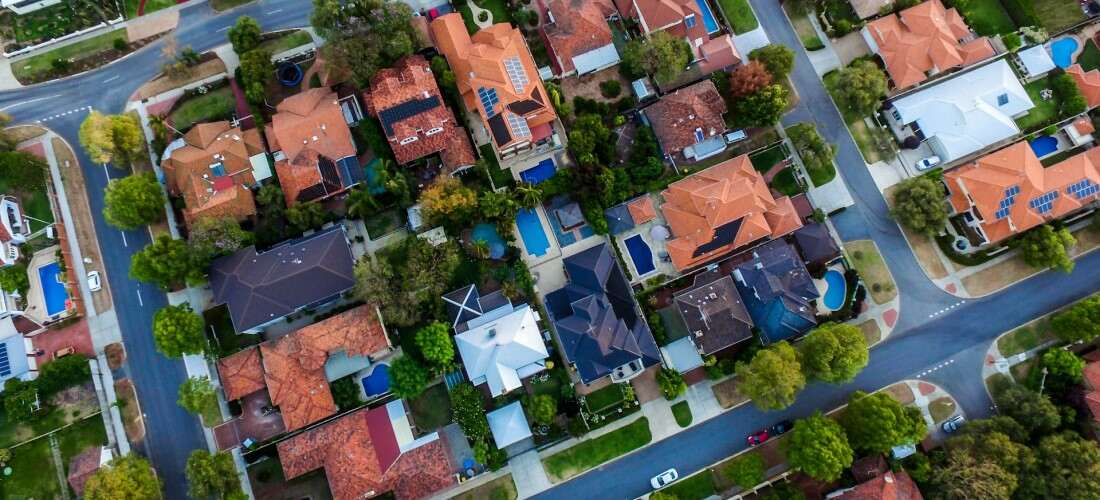
February interest rate update
Key points
- The RBA will keep the cash rate at 4.35 per cent following its February meeting.
- The RBA revised down both their CPI and GDP forecasts, particularly for 2024, and reduced its ‘tightening’ bias on the cash rate outlook.
- The RBA’s forecasts are consistent with rate cuts.
- Assuming the forecasts are right, Australia’s first rate cut will be either late this year or early 2025.
RBA keeps cash rate at 4.35 per cent in February
The cash rate will go unchanged this month following the RBA meeting. However, the RBA did reduce their GDP and CPI forecasts for this year, and modestly so for 2025 (with a tick-up in the projected unemployment rate). The RBA also downgraded (but not completely removed) their tightening bias.
The fact the RBA has only modestly moved its bias on interest rates is not a surprise. We currently have an inflation rate at over 4 per cent, and an unemployment rate of under 4 per cent (still close to its 50-year low). That combination means an emphasis on the upside risk to interest rates.
But, if the RBA’s forecasts are right, the inflation rate will be close to 3 per cent and the unemployment rate will be over 4 per cent by the end of 2024. Then the risks move towards a rate cut.
COVID recovery makes global economies more relevant than ever
The strongest argument for a domestic rate cut in coming months is the outlook for global cash rates. Central banks in most peer economies are talking about reducing interest rates, most likely around the middle of the year.
Our cash rate doesn’t necessarily need to follow global developments, it’s what happens in the domestic economic and inflation data that matters. But this is a co-ordinated economic cycle, substantially driven by the same factor (the recovery from COVID). So the domestic cash rate should be more closely correlated with global outcomes.
The latest data indicates that the CPI is coming down faster than had been predicted. But some inflation indicators have been stuck at around 3.5 per cent since the second half of last year. Annual producer price inflation was also around 4 per cent over that time, as was import price inflation.
That suggests that there is no deflationary force sitting in the pipeline. In its analysis the RBA highlighted the ‘stickiness’ of domestic-driven cost inflation (labour costs, insurance, electricity). But the next stage of the inflation decline is unlikely to be as smooth as what we have seen over the past year.
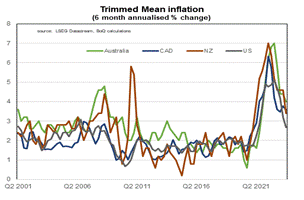
Australia's 'underlying' inflation rate is higher than in peer economies like Canada, New Zealand, and the USA.
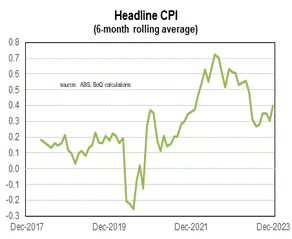
Declines in the headline monthly rate of inflation plateaued in the second half of last year.
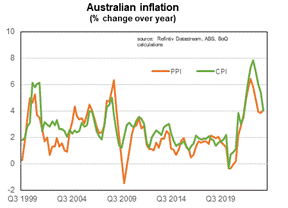
Producer prices are no longer providing a deflationary force to the CPI.
Disposable income growth will strengthen in the second half of 2024
The unemployment rate is on the rise and will almost certainly rise further. But there are growing signs that a big increase is unlikely. Economic growth was sub-par in H2 2023, and that is likely to be the case again in H1 2024. The main reason for the weakness of economic growth has been the weakness of ‘real’ disposable income growth.
Lower inflation and tax cuts will mean this will be far less of a factor come the second half of this year. Further fiscal easing is likely. The global economy should be in a better place by year-end if the interest rate cuts are delivered in line with current financial market pricing.
Given lower inflation and the high chance of global rate cuts, a domestic cash rate cut at some stage appears likely. Australia currently has a lower cash rate and higher inflation rate than peers. So, rate cuts in Australia should lag those in peer economies.
There is also the possibility of improved economic growth in the second half of the year. That suggests that rate cuts are likely to start either late this year or early the 2025.
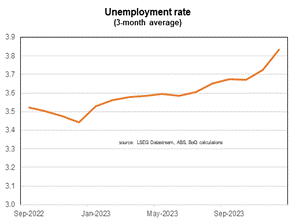
The unemployment rate is well on the rise since 2022.
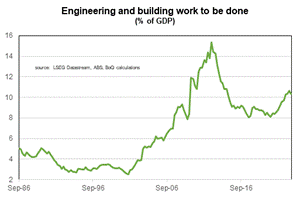
There is a large amount of construction work still in the pipeline for Australia.
How much will interest rates change in Australia?
Over the past 25 years the cash rate has fallen by between 2 – 4.5 per cent during rate cut cycles. But this cycle is different. The level of the cash rate was a lot higher in the 1990s and 2000s when the rate cutting cycle started.
The economic backdrop of the 2010s (slow global economic recovery from the GFC, domestically from the end of the mining boom) was gloomier than it is now. The underlying investment demand is currently strong (the need to build more homes, improve infrastructure, prepare for climate change).
Governments globally are also more likely to use fiscal policy to support the economy than they were in the previous decade.
In recent months financial markets have priced between 3 – 5 quarter percentage points of rate cuts in this cycle. The current pricing of the bottom of the cash rate in peer economies is broadly the same as it is in Australia.
This suggests that the size of the cash rate reduction could be substantially less than what has typically occurred over the past couple of decades.
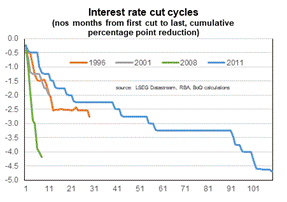
The size of the interest rate reduction in this cycle is likely to be low by historical standards.
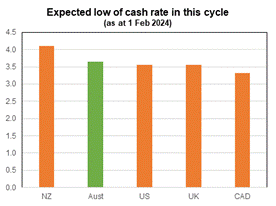
The expected low of the cash rate in Australia is similar to that of peer economies such as New Zealand, US, UK and Canada.
We really do live in interesting times.

